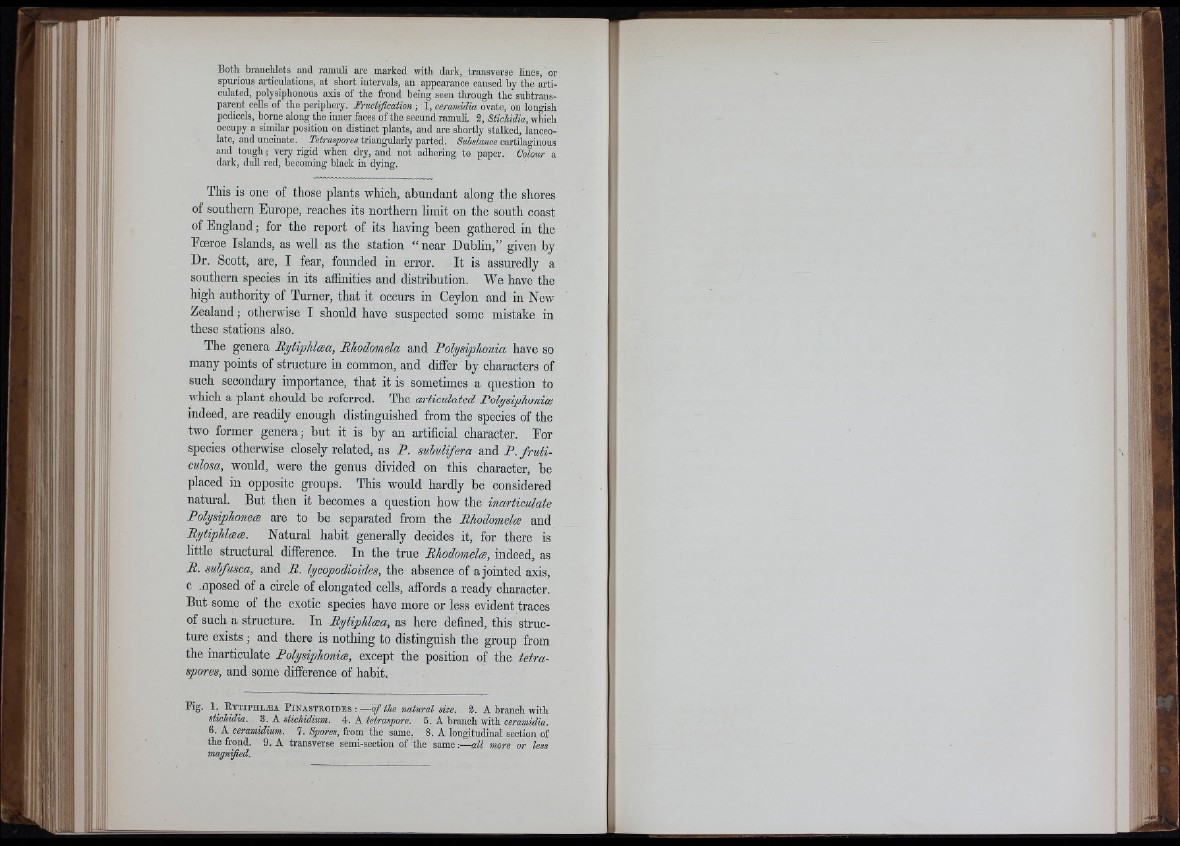
Both branchlets and ramuli are mai-ked with dark, transverse lines, or
spm-ious ai-ticulations, at short intervals, an appearance caused by the articulated,
polysiphonous axis of the frond being seen tlu-ough tbe subtrans-
pai-eut cells of the periphery, fructification ; 1 , ceramidia ovate, on longisb
pedicels, borne along tbe inner faces of tbe secund ramuli, 3, Stichidia, which
occupy a similar position on distinct plants, and are shortly stalked, lanceolate,
and uncinate. Tetraspores triangularly parted. Substance cartilaginous
and tough ; very rigid when dry, and not adhering to paper. Colour a
dark, duU red, becoming black in dying.
This is one of those plants which, abundant along the shores
of southern Europe, reaches its northern limit on the south coast
of England ; for the report of its having been gathered in the
Foeroe Islands, as well as the station “ near Dublin,” given by
Dr. Scott, are, I fear, founded in error. It is assuredly a
southern species in its affinities and distribution. We have the
high authority of Turner, that it occurs in Ceylon and in New
Zealand; otherwise I should have suspected some mistake in
these stations also.
The genera MytipMæa, Rhodomela and Polysiphonia have so
many points of structure in common, and differ by characters of
such secondary importance, that it is sometimes a question to
which a plant should be referred. The articulated Polysiphoniæ
indeed, are readily enough distinguished from the species of the
two former genera; but it is by an artificial character. Eor
species otherwise closely related, as P. mlmlifera and P. fru ticulosa,
would, were the genus divided on this character, be
placed in opposite groups. This would hardly be considered
natiu’al. But then it becomes a question how the inarticulate
Polysiphoneoe are to be separated from the Phodomelæ and
Pytiphloeæ. Natural habit generally decides it, for there is
little structural difference. In the true Phodomelæ, indeed, as
P. subfusca, and P. lycopodioides, the absence of a jointed axis,
c .nposed of a circle of elongated cells, affords a ready character.
But some of the exotic species have more or less evident traces
of such a structure. In Rytiphlæa, as here defined, this structure
exists ; and there is nothing to distinguish the group from
the inarticulate Polysiphoniæ, except the position of the tetraspores,
and some difference of habit.
Fig. 1 .^ E y t ip h læ a P in a s t r o id e s : —o f the natural size. 2 . A branch with
stichidia. 3. A stichidium. 4. A tetraspore. 5. A branch with ceramidia.
6. A ceramidium. 7. Spores, from the same. 8. A longitudinal section of
the frond. 9. A transverse semi-section of the same :—all move or less